Supply Chain Management and Operations Research Proposal, DBA, NMU
VerifiedAdded on 2022/11/24
|20
|5057
|281
Project
AI Summary
This research proposal delves into the critical aspects of supply chain management and operations within commercial establishments. It begins with an executive summary and a detailed table of contents outlining the structure of the proposal. The introduction establishes the study's purpose: to analyze the operations and supply chain departments. The background section explores supply chain and operational practices in both manufacturing and service industries, emphasizing the alignment between supply chain management and operations management. The rationale for the study explains the importance of understanding these practices. The proposal sets out research aims, objectives, and questions, including the role of operations management and supply chain management in business success. A problem statement addresses issues in supply chain management. The literature review examines the opinions of researchers and scholars on the challenges in these departments. The conceptual framework highlights various issues associated with operations and supply chain management. The research methodology covers data collection, analysis, sampling, research design, approach, and ethical considerations. The proposal concludes with a discussion of the significance of the research, time frame, budget, and the researcher's qualifications.
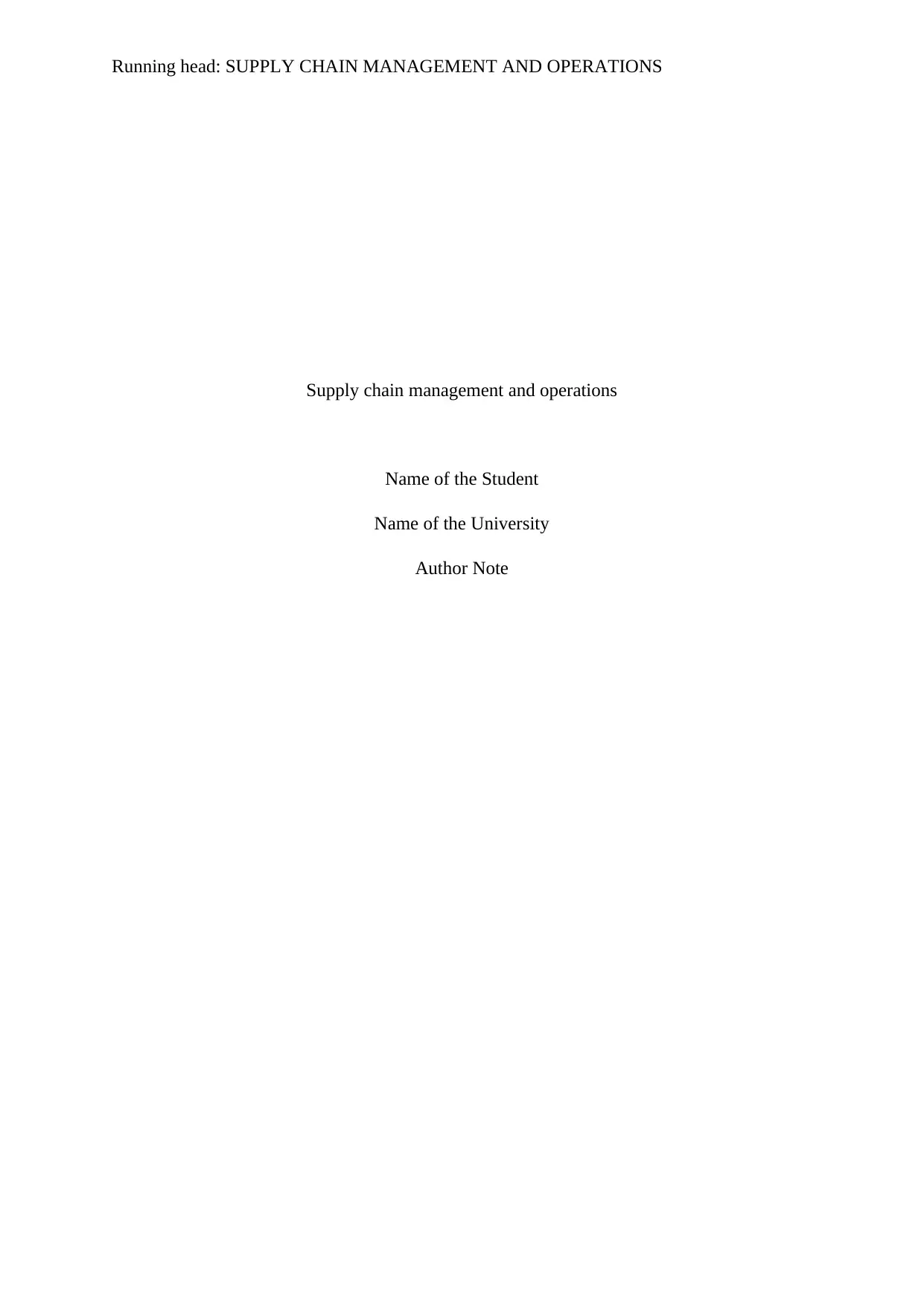
Running head: SUPPLY CHAIN MANAGEMENT AND OPERATIONS
Supply chain management and operations
Name of the Student
Name of the University
Author Note
Supply chain management and operations
Name of the Student
Name of the University
Author Note
Paraphrase This Document
Need a fresh take? Get an instant paraphrase of this document with our AI Paraphraser
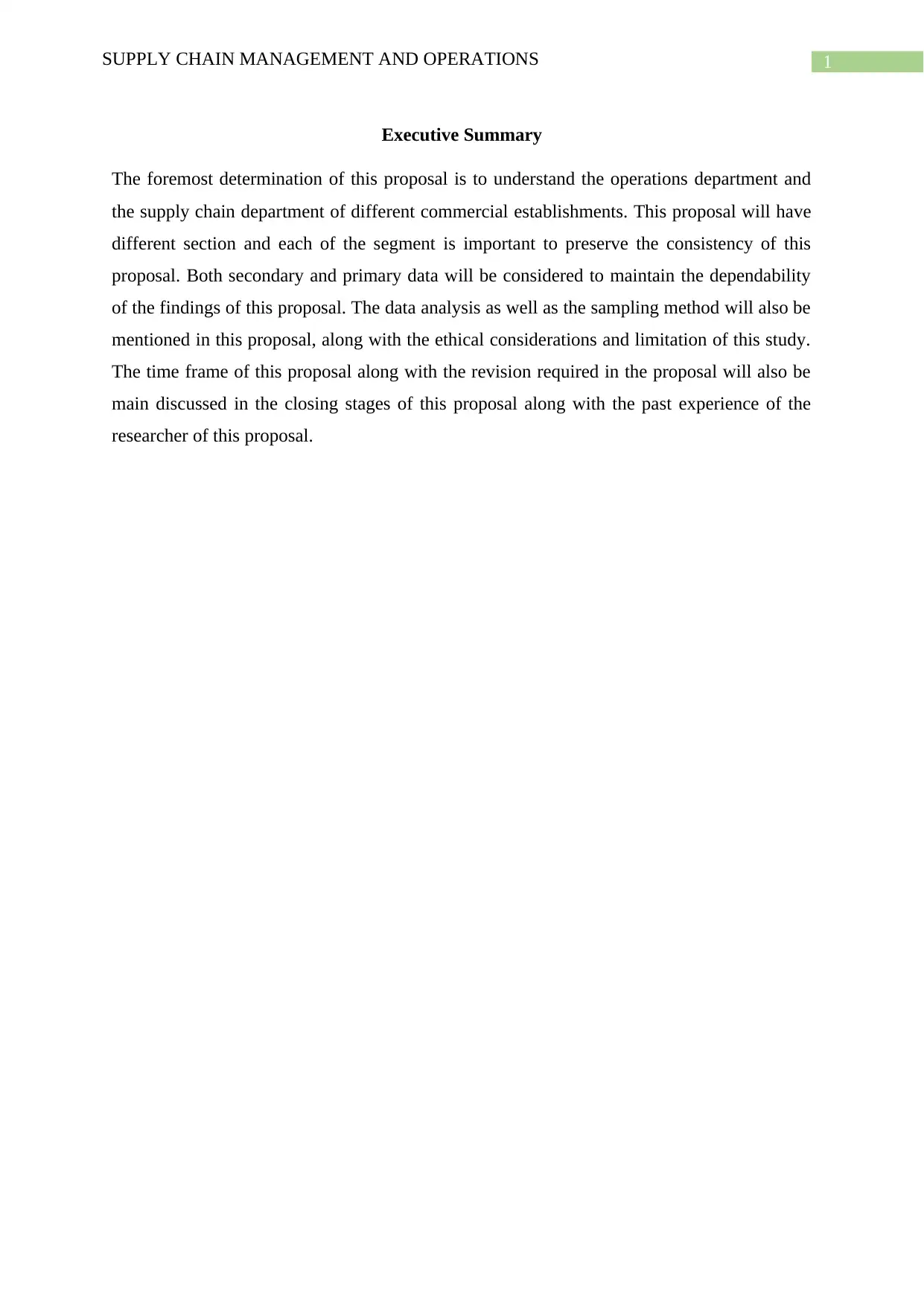
1SUPPLY CHAIN MANAGEMENT AND OPERATIONS
Executive Summary
The foremost determination of this proposal is to understand the operations department and
the supply chain department of different commercial establishments. This proposal will have
different section and each of the segment is important to preserve the consistency of this
proposal. Both secondary and primary data will be considered to maintain the dependability
of the findings of this proposal. The data analysis as well as the sampling method will also be
mentioned in this proposal, along with the ethical considerations and limitation of this study.
The time frame of this proposal along with the revision required in the proposal will also be
main discussed in the closing stages of this proposal along with the past experience of the
researcher of this proposal.
Executive Summary
The foremost determination of this proposal is to understand the operations department and
the supply chain department of different commercial establishments. This proposal will have
different section and each of the segment is important to preserve the consistency of this
proposal. Both secondary and primary data will be considered to maintain the dependability
of the findings of this proposal. The data analysis as well as the sampling method will also be
mentioned in this proposal, along with the ethical considerations and limitation of this study.
The time frame of this proposal along with the revision required in the proposal will also be
main discussed in the closing stages of this proposal along with the past experience of the
researcher of this proposal.
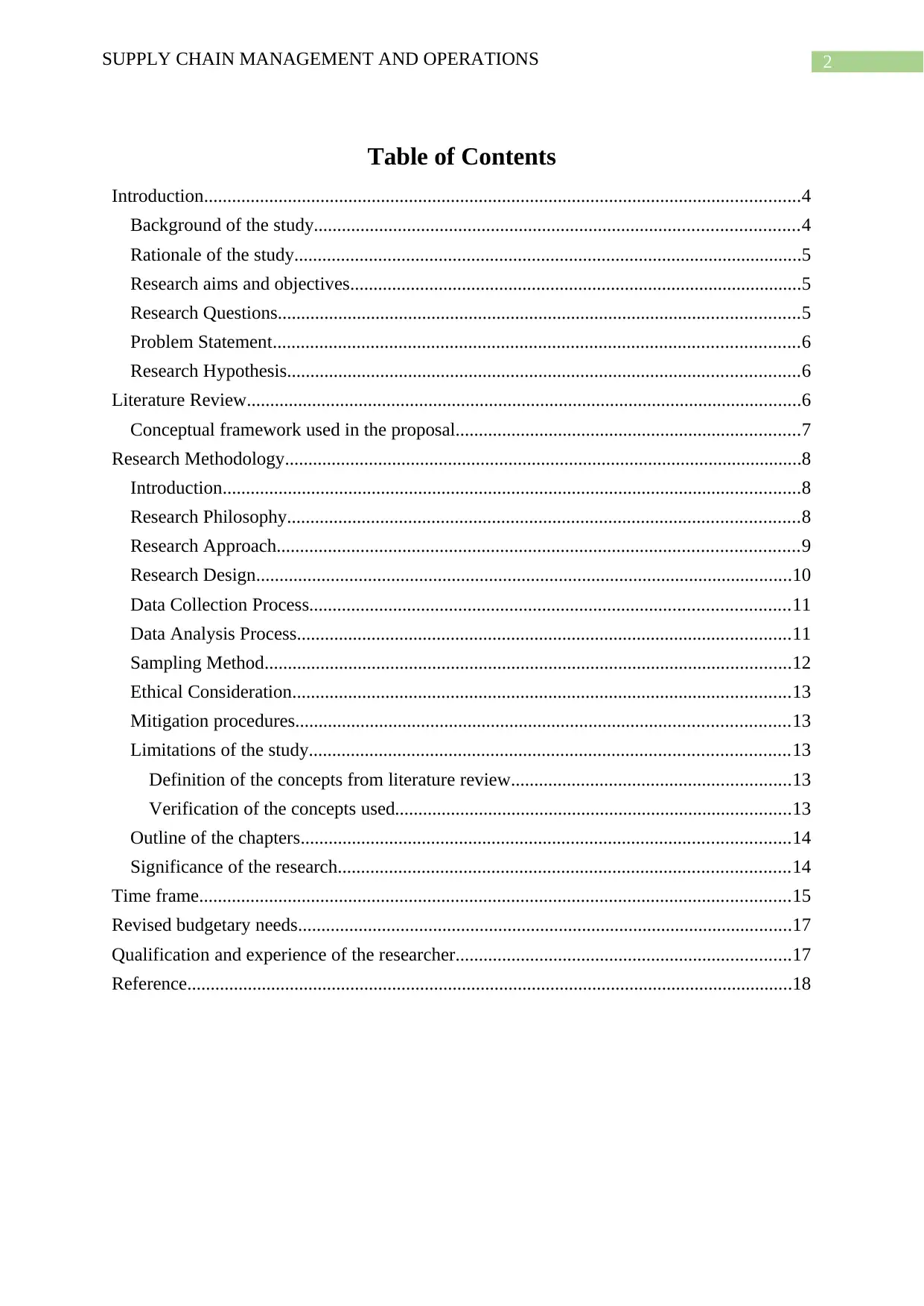
2SUPPLY CHAIN MANAGEMENT AND OPERATIONS
Table of Contents
Introduction................................................................................................................................4
Background of the study........................................................................................................4
Rationale of the study.............................................................................................................5
Research aims and objectives.................................................................................................5
Research Questions................................................................................................................5
Problem Statement.................................................................................................................6
Research Hypothesis..............................................................................................................6
Literature Review.......................................................................................................................6
Conceptual framework used in the proposal..........................................................................7
Research Methodology...............................................................................................................8
Introduction............................................................................................................................8
Research Philosophy..............................................................................................................8
Research Approach................................................................................................................9
Research Design...................................................................................................................10
Data Collection Process.......................................................................................................11
Data Analysis Process..........................................................................................................11
Sampling Method.................................................................................................................12
Ethical Consideration...........................................................................................................13
Mitigation procedures..........................................................................................................13
Limitations of the study.......................................................................................................13
Definition of the concepts from literature review............................................................13
Verification of the concepts used.....................................................................................13
Outline of the chapters.........................................................................................................14
Significance of the research.................................................................................................14
Time frame...............................................................................................................................15
Revised budgetary needs..........................................................................................................17
Qualification and experience of the researcher........................................................................17
Reference..................................................................................................................................18
Table of Contents
Introduction................................................................................................................................4
Background of the study........................................................................................................4
Rationale of the study.............................................................................................................5
Research aims and objectives.................................................................................................5
Research Questions................................................................................................................5
Problem Statement.................................................................................................................6
Research Hypothesis..............................................................................................................6
Literature Review.......................................................................................................................6
Conceptual framework used in the proposal..........................................................................7
Research Methodology...............................................................................................................8
Introduction............................................................................................................................8
Research Philosophy..............................................................................................................8
Research Approach................................................................................................................9
Research Design...................................................................................................................10
Data Collection Process.......................................................................................................11
Data Analysis Process..........................................................................................................11
Sampling Method.................................................................................................................12
Ethical Consideration...........................................................................................................13
Mitigation procedures..........................................................................................................13
Limitations of the study.......................................................................................................13
Definition of the concepts from literature review............................................................13
Verification of the concepts used.....................................................................................13
Outline of the chapters.........................................................................................................14
Significance of the research.................................................................................................14
Time frame...............................................................................................................................15
Revised budgetary needs..........................................................................................................17
Qualification and experience of the researcher........................................................................17
Reference..................................................................................................................................18
⊘ This is a preview!⊘
Do you want full access?
Subscribe today to unlock all pages.

Trusted by 1+ million students worldwide
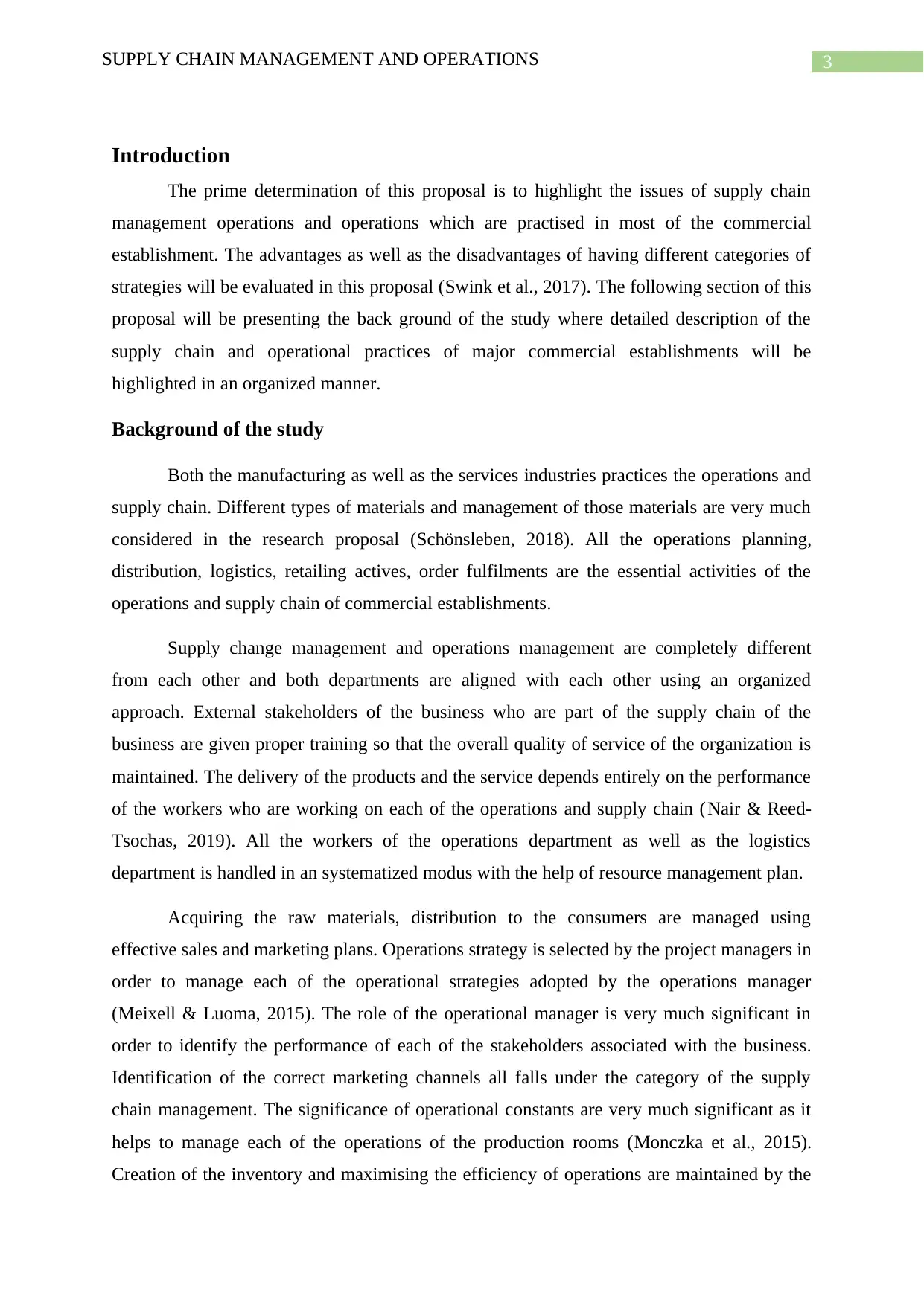
3SUPPLY CHAIN MANAGEMENT AND OPERATIONS
Introduction
The prime determination of this proposal is to highlight the issues of supply chain
management operations and operations which are practised in most of the commercial
establishment. The advantages as well as the disadvantages of having different categories of
strategies will be evaluated in this proposal (Swink et al., 2017). The following section of this
proposal will be presenting the back ground of the study where detailed description of the
supply chain and operational practices of major commercial establishments will be
highlighted in an organized manner.
Background of the study
Both the manufacturing as well as the services industries practices the operations and
supply chain. Different types of materials and management of those materials are very much
considered in the research proposal (Schönsleben, 2018). All the operations planning,
distribution, logistics, retailing actives, order fulfilments are the essential activities of the
operations and supply chain of commercial establishments.
Supply change management and operations management are completely different
from each other and both departments are aligned with each other using an organized
approach. External stakeholders of the business who are part of the supply chain of the
business are given proper training so that the overall quality of service of the organization is
maintained. The delivery of the products and the service depends entirely on the performance
of the workers who are working on each of the operations and supply chain (Nair & Reed‐
Tsochas, 2019). All the workers of the operations department as well as the logistics
department is handled in an systematized modus with the help of resource management plan.
Acquiring the raw materials, distribution to the consumers are managed using
effective sales and marketing plans. Operations strategy is selected by the project managers in
order to manage each of the operational strategies adopted by the operations manager
(Meixell & Luoma, 2015). The role of the operational manager is very much significant in
order to identify the performance of each of the stakeholders associated with the business.
Identification of the correct marketing channels all falls under the category of the supply
chain management. The significance of operational constants are very much significant as it
helps to manage each of the operations of the production rooms (Monczka et al., 2015).
Creation of the inventory and maximising the efficiency of operations are maintained by the
Introduction
The prime determination of this proposal is to highlight the issues of supply chain
management operations and operations which are practised in most of the commercial
establishment. The advantages as well as the disadvantages of having different categories of
strategies will be evaluated in this proposal (Swink et al., 2017). The following section of this
proposal will be presenting the back ground of the study where detailed description of the
supply chain and operational practices of major commercial establishments will be
highlighted in an organized manner.
Background of the study
Both the manufacturing as well as the services industries practices the operations and
supply chain. Different types of materials and management of those materials are very much
considered in the research proposal (Schönsleben, 2018). All the operations planning,
distribution, logistics, retailing actives, order fulfilments are the essential activities of the
operations and supply chain of commercial establishments.
Supply change management and operations management are completely different
from each other and both departments are aligned with each other using an organized
approach. External stakeholders of the business who are part of the supply chain of the
business are given proper training so that the overall quality of service of the organization is
maintained. The delivery of the products and the service depends entirely on the performance
of the workers who are working on each of the operations and supply chain (Nair & Reed‐
Tsochas, 2019). All the workers of the operations department as well as the logistics
department is handled in an systematized modus with the help of resource management plan.
Acquiring the raw materials, distribution to the consumers are managed using
effective sales and marketing plans. Operations strategy is selected by the project managers in
order to manage each of the operational strategies adopted by the operations manager
(Meixell & Luoma, 2015). The role of the operational manager is very much significant in
order to identify the performance of each of the stakeholders associated with the business.
Identification of the correct marketing channels all falls under the category of the supply
chain management. The significance of operational constants are very much significant as it
helps to manage each of the operations of the production rooms (Monczka et al., 2015).
Creation of the inventory and maximising the efficiency of operations are maintained by the
Paraphrase This Document
Need a fresh take? Get an instant paraphrase of this document with our AI Paraphraser
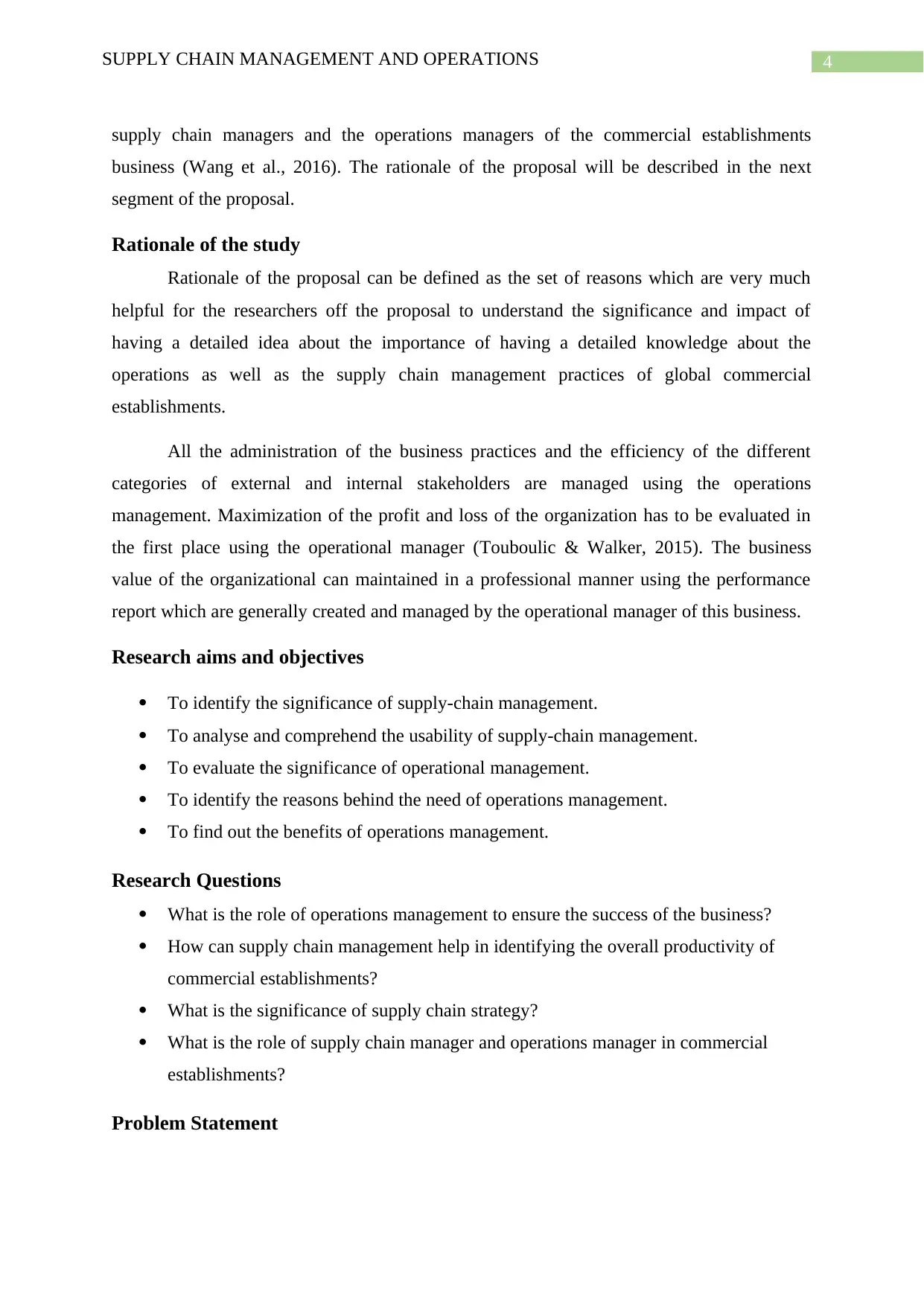
4SUPPLY CHAIN MANAGEMENT AND OPERATIONS
supply chain managers and the operations managers of the commercial establishments
business (Wang et al., 2016). The rationale of the proposal will be described in the next
segment of the proposal.
Rationale of the study
Rationale of the proposal can be defined as the set of reasons which are very much
helpful for the researchers off the proposal to understand the significance and impact of
having a detailed idea about the importance of having a detailed knowledge about the
operations as well as the supply chain management practices of global commercial
establishments.
All the administration of the business practices and the efficiency of the different
categories of external and internal stakeholders are managed using the operations
management. Maximization of the profit and loss of the organization has to be evaluated in
the first place using the operational manager (Touboulic & Walker, 2015). The business
value of the organizational can maintained in a professional manner using the performance
report which are generally created and managed by the operational manager of this business.
Research aims and objectives
To identify the significance of supply-chain management.
To analyse and comprehend the usability of supply-chain management.
To evaluate the significance of operational management.
To identify the reasons behind the need of operations management.
To find out the benefits of operations management.
Research Questions
What is the role of operations management to ensure the success of the business?
How can supply chain management help in identifying the overall productivity of
commercial establishments?
What is the significance of supply chain strategy?
What is the role of supply chain manager and operations manager in commercial
establishments?
Problem Statement
supply chain managers and the operations managers of the commercial establishments
business (Wang et al., 2016). The rationale of the proposal will be described in the next
segment of the proposal.
Rationale of the study
Rationale of the proposal can be defined as the set of reasons which are very much
helpful for the researchers off the proposal to understand the significance and impact of
having a detailed idea about the importance of having a detailed knowledge about the
operations as well as the supply chain management practices of global commercial
establishments.
All the administration of the business practices and the efficiency of the different
categories of external and internal stakeholders are managed using the operations
management. Maximization of the profit and loss of the organization has to be evaluated in
the first place using the operational manager (Touboulic & Walker, 2015). The business
value of the organizational can maintained in a professional manner using the performance
report which are generally created and managed by the operational manager of this business.
Research aims and objectives
To identify the significance of supply-chain management.
To analyse and comprehend the usability of supply-chain management.
To evaluate the significance of operational management.
To identify the reasons behind the need of operations management.
To find out the benefits of operations management.
Research Questions
What is the role of operations management to ensure the success of the business?
How can supply chain management help in identifying the overall productivity of
commercial establishments?
What is the significance of supply chain strategy?
What is the role of supply chain manager and operations manager in commercial
establishments?
Problem Statement
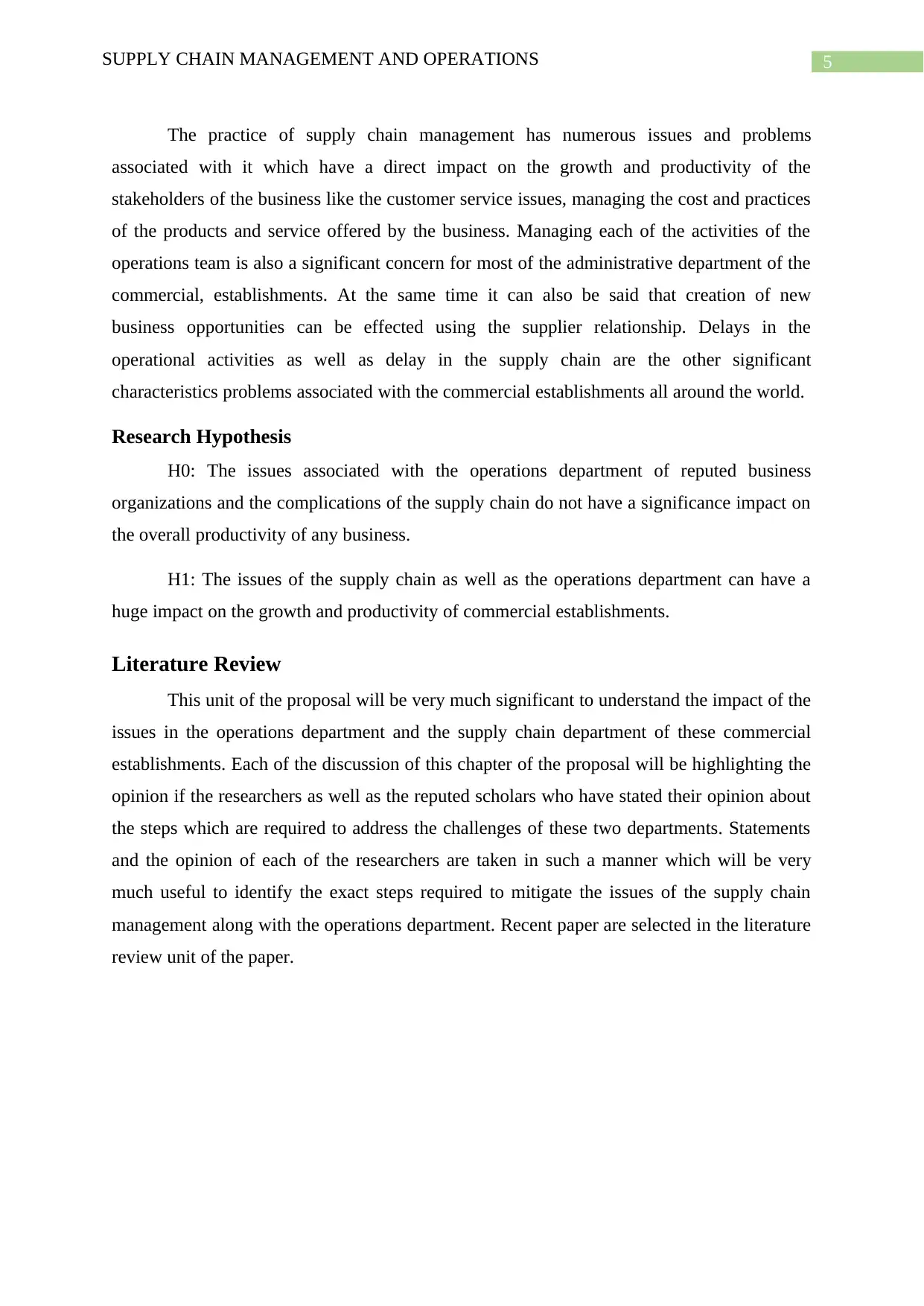
5SUPPLY CHAIN MANAGEMENT AND OPERATIONS
The practice of supply chain management has numerous issues and problems
associated with it which have a direct impact on the growth and productivity of the
stakeholders of the business like the customer service issues, managing the cost and practices
of the products and service offered by the business. Managing each of the activities of the
operations team is also a significant concern for most of the administrative department of the
commercial, establishments. At the same time it can also be said that creation of new
business opportunities can be effected using the supplier relationship. Delays in the
operational activities as well as delay in the supply chain are the other significant
characteristics problems associated with the commercial establishments all around the world.
Research Hypothesis
H0: The issues associated with the operations department of reputed business
organizations and the complications of the supply chain do not have a significance impact on
the overall productivity of any business.
H1: The issues of the supply chain as well as the operations department can have a
huge impact on the growth and productivity of commercial establishments.
Literature Review
This unit of the proposal will be very much significant to understand the impact of the
issues in the operations department and the supply chain department of these commercial
establishments. Each of the discussion of this chapter of the proposal will be highlighting the
opinion if the researchers as well as the reputed scholars who have stated their opinion about
the steps which are required to address the challenges of these two departments. Statements
and the opinion of each of the researchers are taken in such a manner which will be very
much useful to identify the exact steps required to mitigate the issues of the supply chain
management along with the operations department. Recent paper are selected in the literature
review unit of the paper.
The practice of supply chain management has numerous issues and problems
associated with it which have a direct impact on the growth and productivity of the
stakeholders of the business like the customer service issues, managing the cost and practices
of the products and service offered by the business. Managing each of the activities of the
operations team is also a significant concern for most of the administrative department of the
commercial, establishments. At the same time it can also be said that creation of new
business opportunities can be effected using the supplier relationship. Delays in the
operational activities as well as delay in the supply chain are the other significant
characteristics problems associated with the commercial establishments all around the world.
Research Hypothesis
H0: The issues associated with the operations department of reputed business
organizations and the complications of the supply chain do not have a significance impact on
the overall productivity of any business.
H1: The issues of the supply chain as well as the operations department can have a
huge impact on the growth and productivity of commercial establishments.
Literature Review
This unit of the proposal will be very much significant to understand the impact of the
issues in the operations department and the supply chain department of these commercial
establishments. Each of the discussion of this chapter of the proposal will be highlighting the
opinion if the researchers as well as the reputed scholars who have stated their opinion about
the steps which are required to address the challenges of these two departments. Statements
and the opinion of each of the researchers are taken in such a manner which will be very
much useful to identify the exact steps required to mitigate the issues of the supply chain
management along with the operations department. Recent paper are selected in the literature
review unit of the paper.
⊘ This is a preview!⊘
Do you want full access?
Subscribe today to unlock all pages.

Trusted by 1+ million students worldwide
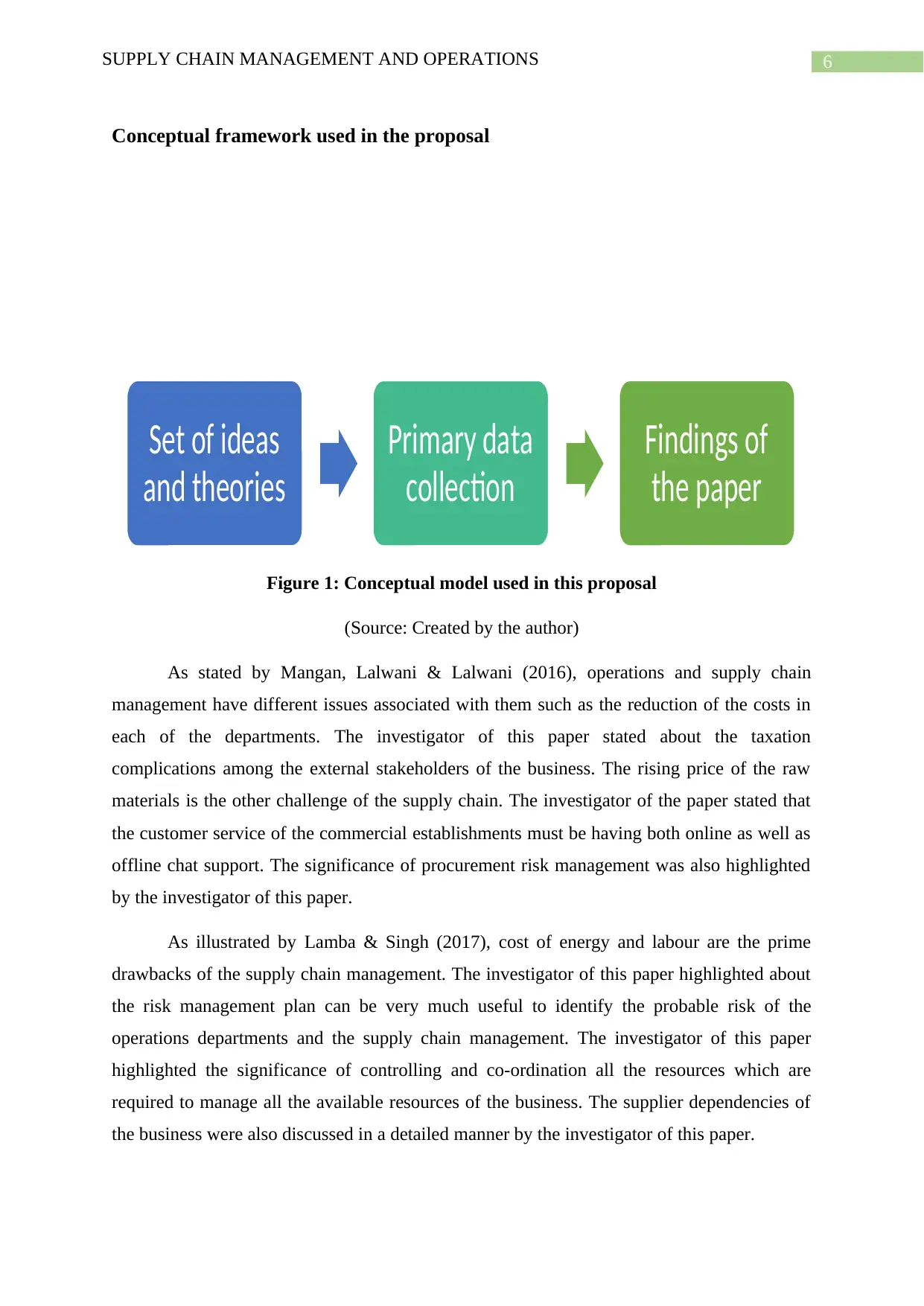
6SUPPLY CHAIN MANAGEMENT AND OPERATIONS
Conceptual framework used in the proposal
Figure 1: Conceptual model used in this proposal
(Source: Created by the author)
As stated by Mangan, Lalwani & Lalwani (2016), operations and supply chain
management have different issues associated with them such as the reduction of the costs in
each of the departments. The investigator of this paper stated about the taxation
complications among the external stakeholders of the business. The rising price of the raw
materials is the other challenge of the supply chain. The investigator of the paper stated that
the customer service of the commercial establishments must be having both online as well as
offline chat support. The significance of procurement risk management was also highlighted
by the investigator of this paper.
As illustrated by Lamba & Singh (2017), cost of energy and labour are the prime
drawbacks of the supply chain management. The investigator of this paper highlighted about
the risk management plan can be very much useful to identify the probable risk of the
operations departments and the supply chain management. The investigator of this paper
highlighted the significance of controlling and co-ordination all the resources which are
required to manage all the available resources of the business. The supplier dependencies of
the business were also discussed in a detailed manner by the investigator of this paper.
Set of ideas
and theories
Primary data
collection
Findings of
the paper
Conceptual framework used in the proposal
Figure 1: Conceptual model used in this proposal
(Source: Created by the author)
As stated by Mangan, Lalwani & Lalwani (2016), operations and supply chain
management have different issues associated with them such as the reduction of the costs in
each of the departments. The investigator of this paper stated about the taxation
complications among the external stakeholders of the business. The rising price of the raw
materials is the other challenge of the supply chain. The investigator of the paper stated that
the customer service of the commercial establishments must be having both online as well as
offline chat support. The significance of procurement risk management was also highlighted
by the investigator of this paper.
As illustrated by Lamba & Singh (2017), cost of energy and labour are the prime
drawbacks of the supply chain management. The investigator of this paper highlighted about
the risk management plan can be very much useful to identify the probable risk of the
operations departments and the supply chain management. The investigator of this paper
highlighted the significance of controlling and co-ordination all the resources which are
required to manage all the available resources of the business. The supplier dependencies of
the business were also discussed in a detailed manner by the investigator of this paper.
Set of ideas
and theories
Primary data
collection
Findings of
the paper
Paraphrase This Document
Need a fresh take? Get an instant paraphrase of this document with our AI Paraphraser
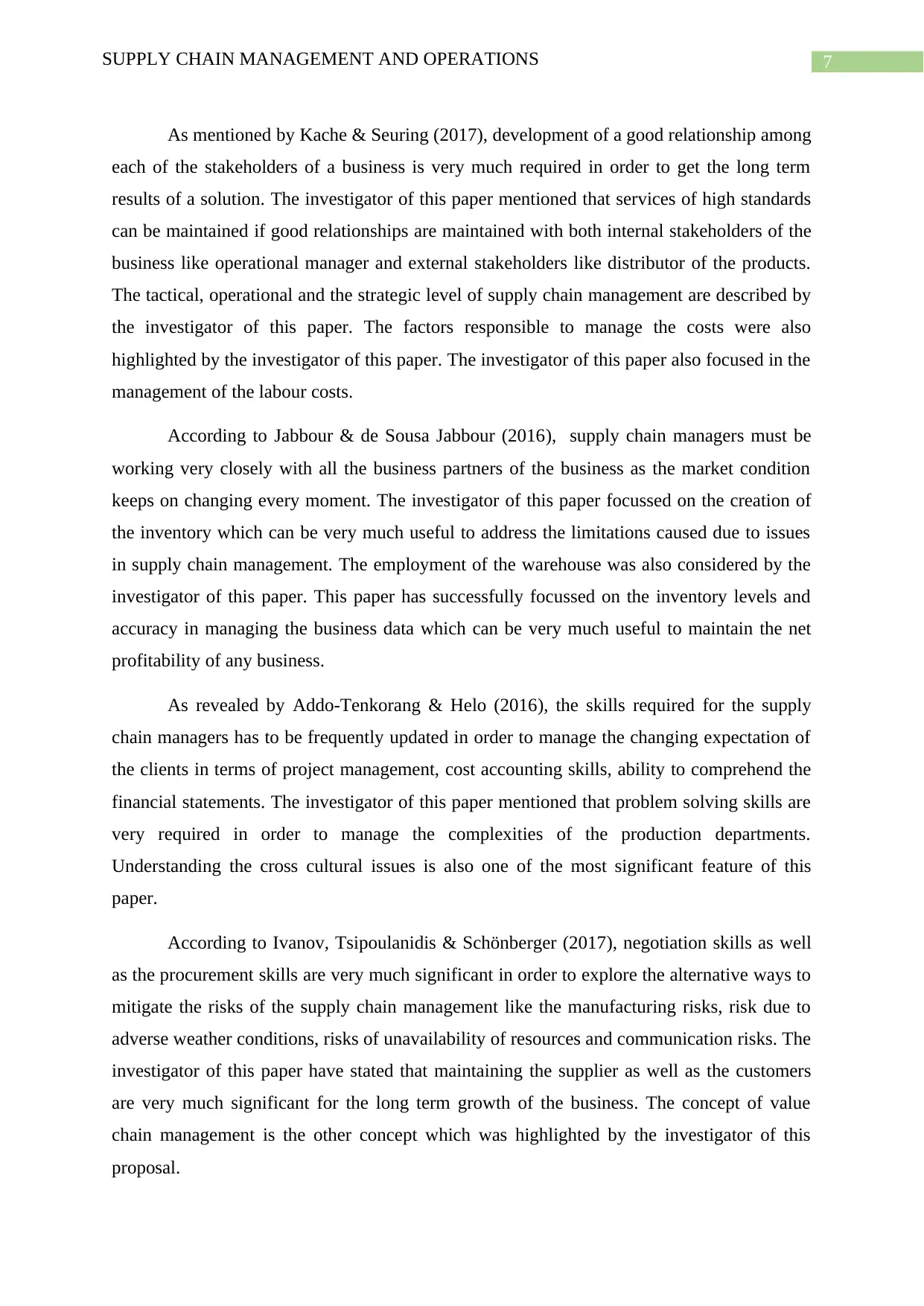
7SUPPLY CHAIN MANAGEMENT AND OPERATIONS
As mentioned by Kache & Seuring (2017), development of a good relationship among
each of the stakeholders of a business is very much required in order to get the long term
results of a solution. The investigator of this paper mentioned that services of high standards
can be maintained if good relationships are maintained with both internal stakeholders of the
business like operational manager and external stakeholders like distributor of the products.
The tactical, operational and the strategic level of supply chain management are described by
the investigator of this paper. The factors responsible to manage the costs were also
highlighted by the investigator of this paper. The investigator of this paper also focused in the
management of the labour costs.
According to Jabbour & de Sousa Jabbour (2016), supply chain managers must be
working very closely with all the business partners of the business as the market condition
keeps on changing every moment. The investigator of this paper focussed on the creation of
the inventory which can be very much useful to address the limitations caused due to issues
in supply chain management. The employment of the warehouse was also considered by the
investigator of this paper. This paper has successfully focussed on the inventory levels and
accuracy in managing the business data which can be very much useful to maintain the net
profitability of any business.
As revealed by Addo-Tenkorang & Helo (2016), the skills required for the supply
chain managers has to be frequently updated in order to manage the changing expectation of
the clients in terms of project management, cost accounting skills, ability to comprehend the
financial statements. The investigator of this paper mentioned that problem solving skills are
very required in order to manage the complexities of the production departments.
Understanding the cross cultural issues is also one of the most significant feature of this
paper.
According to Ivanov, Tsipoulanidis & Schönberger (2017), negotiation skills as well
as the procurement skills are very much significant in order to explore the alternative ways to
mitigate the risks of the supply chain management like the manufacturing risks, risk due to
adverse weather conditions, risks of unavailability of resources and communication risks. The
investigator of this paper have stated that maintaining the supplier as well as the customers
are very much significant for the long term growth of the business. The concept of value
chain management is the other concept which was highlighted by the investigator of this
proposal.
As mentioned by Kache & Seuring (2017), development of a good relationship among
each of the stakeholders of a business is very much required in order to get the long term
results of a solution. The investigator of this paper mentioned that services of high standards
can be maintained if good relationships are maintained with both internal stakeholders of the
business like operational manager and external stakeholders like distributor of the products.
The tactical, operational and the strategic level of supply chain management are described by
the investigator of this paper. The factors responsible to manage the costs were also
highlighted by the investigator of this paper. The investigator of this paper also focused in the
management of the labour costs.
According to Jabbour & de Sousa Jabbour (2016), supply chain managers must be
working very closely with all the business partners of the business as the market condition
keeps on changing every moment. The investigator of this paper focussed on the creation of
the inventory which can be very much useful to address the limitations caused due to issues
in supply chain management. The employment of the warehouse was also considered by the
investigator of this paper. This paper has successfully focussed on the inventory levels and
accuracy in managing the business data which can be very much useful to maintain the net
profitability of any business.
As revealed by Addo-Tenkorang & Helo (2016), the skills required for the supply
chain managers has to be frequently updated in order to manage the changing expectation of
the clients in terms of project management, cost accounting skills, ability to comprehend the
financial statements. The investigator of this paper mentioned that problem solving skills are
very required in order to manage the complexities of the production departments.
Understanding the cross cultural issues is also one of the most significant feature of this
paper.
According to Ivanov, Tsipoulanidis & Schönberger (2017), negotiation skills as well
as the procurement skills are very much significant in order to explore the alternative ways to
mitigate the risks of the supply chain management like the manufacturing risks, risk due to
adverse weather conditions, risks of unavailability of resources and communication risks. The
investigator of this paper have stated that maintaining the supplier as well as the customers
are very much significant for the long term growth of the business. The concept of value
chain management is the other concept which was highlighted by the investigator of this
proposal.
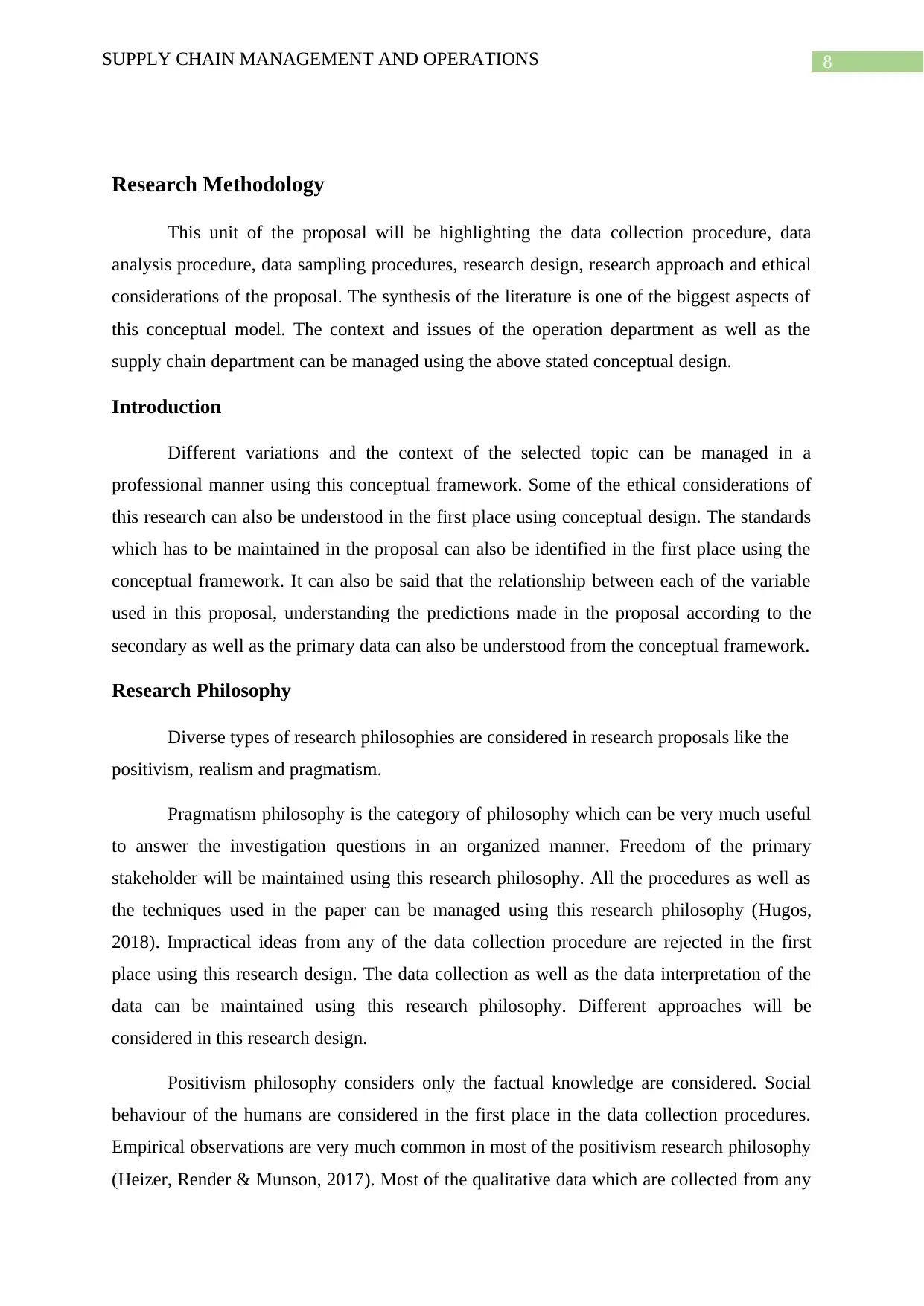
8SUPPLY CHAIN MANAGEMENT AND OPERATIONS
Research Methodology
This unit of the proposal will be highlighting the data collection procedure, data
analysis procedure, data sampling procedures, research design, research approach and ethical
considerations of the proposal. The synthesis of the literature is one of the biggest aspects of
this conceptual model. The context and issues of the operation department as well as the
supply chain department can be managed using the above stated conceptual design.
Introduction
Different variations and the context of the selected topic can be managed in a
professional manner using this conceptual framework. Some of the ethical considerations of
this research can also be understood in the first place using conceptual design. The standards
which has to be maintained in the proposal can also be identified in the first place using the
conceptual framework. It can also be said that the relationship between each of the variable
used in this proposal, understanding the predictions made in the proposal according to the
secondary as well as the primary data can also be understood from the conceptual framework.
Research Philosophy
Diverse types of research philosophies are considered in research proposals like the
positivism, realism and pragmatism.
Pragmatism philosophy is the category of philosophy which can be very much useful
to answer the investigation questions in an organized manner. Freedom of the primary
stakeholder will be maintained using this research philosophy. All the procedures as well as
the techniques used in the paper can be managed using this research philosophy (Hugos,
2018). Impractical ideas from any of the data collection procedure are rejected in the first
place using this research design. The data collection as well as the data interpretation of the
data can be maintained using this research philosophy. Different approaches will be
considered in this research design.
Positivism philosophy considers only the factual knowledge are considered. Social
behaviour of the humans are considered in the first place in the data collection procedures.
Empirical observations are very much common in most of the positivism research philosophy
(Heizer, Render & Munson, 2017). Most of the qualitative data which are collected from any
Research Methodology
This unit of the proposal will be highlighting the data collection procedure, data
analysis procedure, data sampling procedures, research design, research approach and ethical
considerations of the proposal. The synthesis of the literature is one of the biggest aspects of
this conceptual model. The context and issues of the operation department as well as the
supply chain department can be managed using the above stated conceptual design.
Introduction
Different variations and the context of the selected topic can be managed in a
professional manner using this conceptual framework. Some of the ethical considerations of
this research can also be understood in the first place using conceptual design. The standards
which has to be maintained in the proposal can also be identified in the first place using the
conceptual framework. It can also be said that the relationship between each of the variable
used in this proposal, understanding the predictions made in the proposal according to the
secondary as well as the primary data can also be understood from the conceptual framework.
Research Philosophy
Diverse types of research philosophies are considered in research proposals like the
positivism, realism and pragmatism.
Pragmatism philosophy is the category of philosophy which can be very much useful
to answer the investigation questions in an organized manner. Freedom of the primary
stakeholder will be maintained using this research philosophy. All the procedures as well as
the techniques used in the paper can be managed using this research philosophy (Hugos,
2018). Impractical ideas from any of the data collection procedure are rejected in the first
place using this research design. The data collection as well as the data interpretation of the
data can be maintained using this research philosophy. Different approaches will be
considered in this research design.
Positivism philosophy considers only the factual knowledge are considered. Social
behaviour of the humans are considered in the first place in the data collection procedures.
Empirical observations are very much common in most of the positivism research philosophy
(Heizer, Render & Munson, 2017). Most of the qualitative data which are collected from any
⊘ This is a preview!⊘
Do you want full access?
Subscribe today to unlock all pages.

Trusted by 1+ million students worldwide
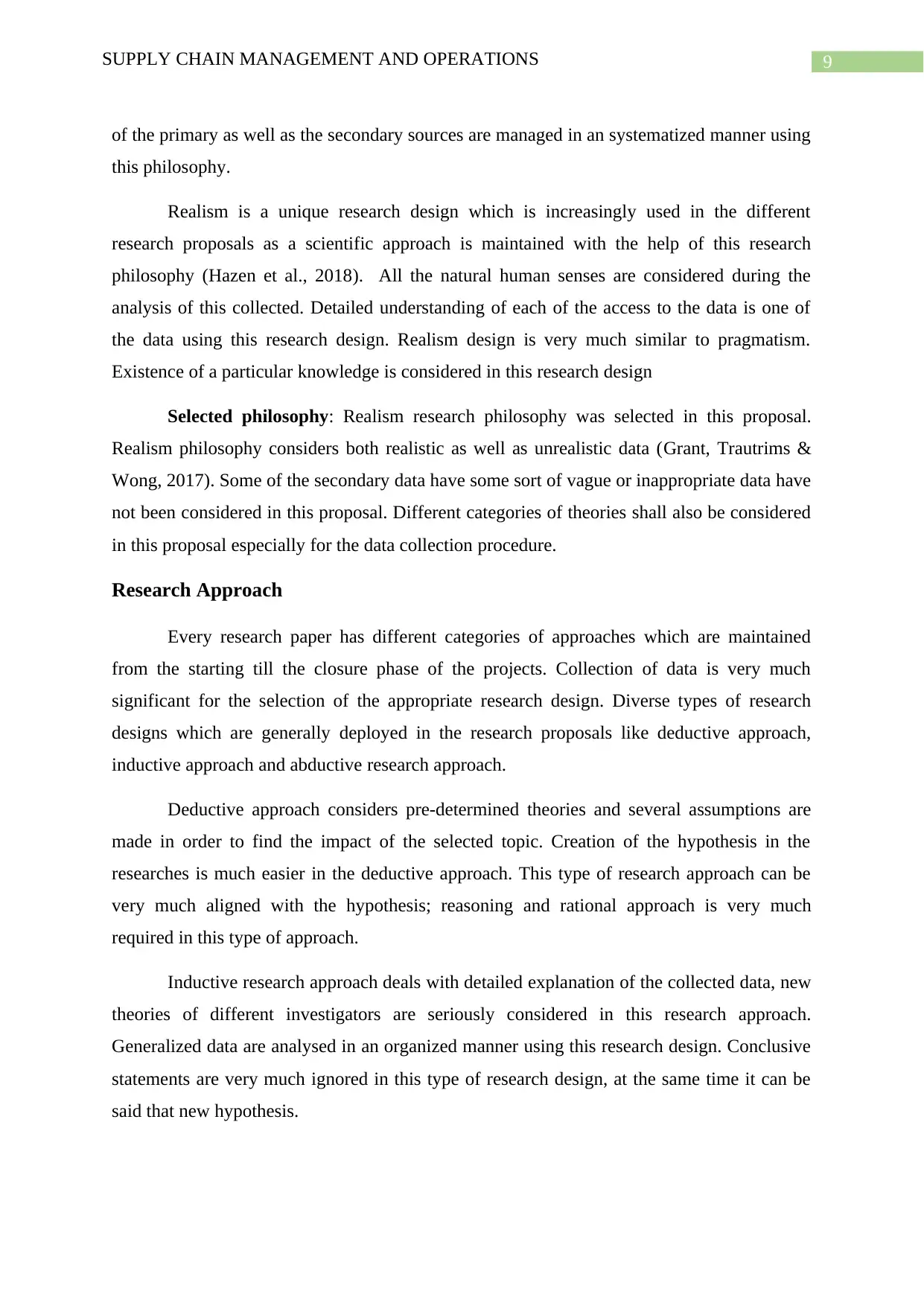
9SUPPLY CHAIN MANAGEMENT AND OPERATIONS
of the primary as well as the secondary sources are managed in an systematized manner using
this philosophy.
Realism is a unique research design which is increasingly used in the different
research proposals as a scientific approach is maintained with the help of this research
philosophy (Hazen et al., 2018). All the natural human senses are considered during the
analysis of this collected. Detailed understanding of each of the access to the data is one of
the data using this research design. Realism design is very much similar to pragmatism.
Existence of a particular knowledge is considered in this research design
Selected philosophy: Realism research philosophy was selected in this proposal.
Realism philosophy considers both realistic as well as unrealistic data (Grant, Trautrims &
Wong, 2017). Some of the secondary data have some sort of vague or inappropriate data have
not been considered in this proposal. Different categories of theories shall also be considered
in this proposal especially for the data collection procedure.
Research Approach
Every research paper has different categories of approaches which are maintained
from the starting till the closure phase of the projects. Collection of data is very much
significant for the selection of the appropriate research design. Diverse types of research
designs which are generally deployed in the research proposals like deductive approach,
inductive approach and abductive research approach.
Deductive approach considers pre-determined theories and several assumptions are
made in order to find the impact of the selected topic. Creation of the hypothesis in the
researches is much easier in the deductive approach. This type of research approach can be
very much aligned with the hypothesis; reasoning and rational approach is very much
required in this type of approach.
Inductive research approach deals with detailed explanation of the collected data, new
theories of different investigators are seriously considered in this research approach.
Generalized data are analysed in an organized manner using this research design. Conclusive
statements are very much ignored in this type of research design, at the same time it can be
said that new hypothesis.
of the primary as well as the secondary sources are managed in an systematized manner using
this philosophy.
Realism is a unique research design which is increasingly used in the different
research proposals as a scientific approach is maintained with the help of this research
philosophy (Hazen et al., 2018). All the natural human senses are considered during the
analysis of this collected. Detailed understanding of each of the access to the data is one of
the data using this research design. Realism design is very much similar to pragmatism.
Existence of a particular knowledge is considered in this research design
Selected philosophy: Realism research philosophy was selected in this proposal.
Realism philosophy considers both realistic as well as unrealistic data (Grant, Trautrims &
Wong, 2017). Some of the secondary data have some sort of vague or inappropriate data have
not been considered in this proposal. Different categories of theories shall also be considered
in this proposal especially for the data collection procedure.
Research Approach
Every research paper has different categories of approaches which are maintained
from the starting till the closure phase of the projects. Collection of data is very much
significant for the selection of the appropriate research design. Diverse types of research
designs which are generally deployed in the research proposals like deductive approach,
inductive approach and abductive research approach.
Deductive approach considers pre-determined theories and several assumptions are
made in order to find the impact of the selected topic. Creation of the hypothesis in the
researches is much easier in the deductive approach. This type of research approach can be
very much aligned with the hypothesis; reasoning and rational approach is very much
required in this type of approach.
Inductive research approach deals with detailed explanation of the collected data, new
theories of different investigators are seriously considered in this research approach.
Generalized data are analysed in an organized manner using this research design. Conclusive
statements are very much ignored in this type of research design, at the same time it can be
said that new hypothesis.
Paraphrase This Document
Need a fresh take? Get an instant paraphrase of this document with our AI Paraphraser
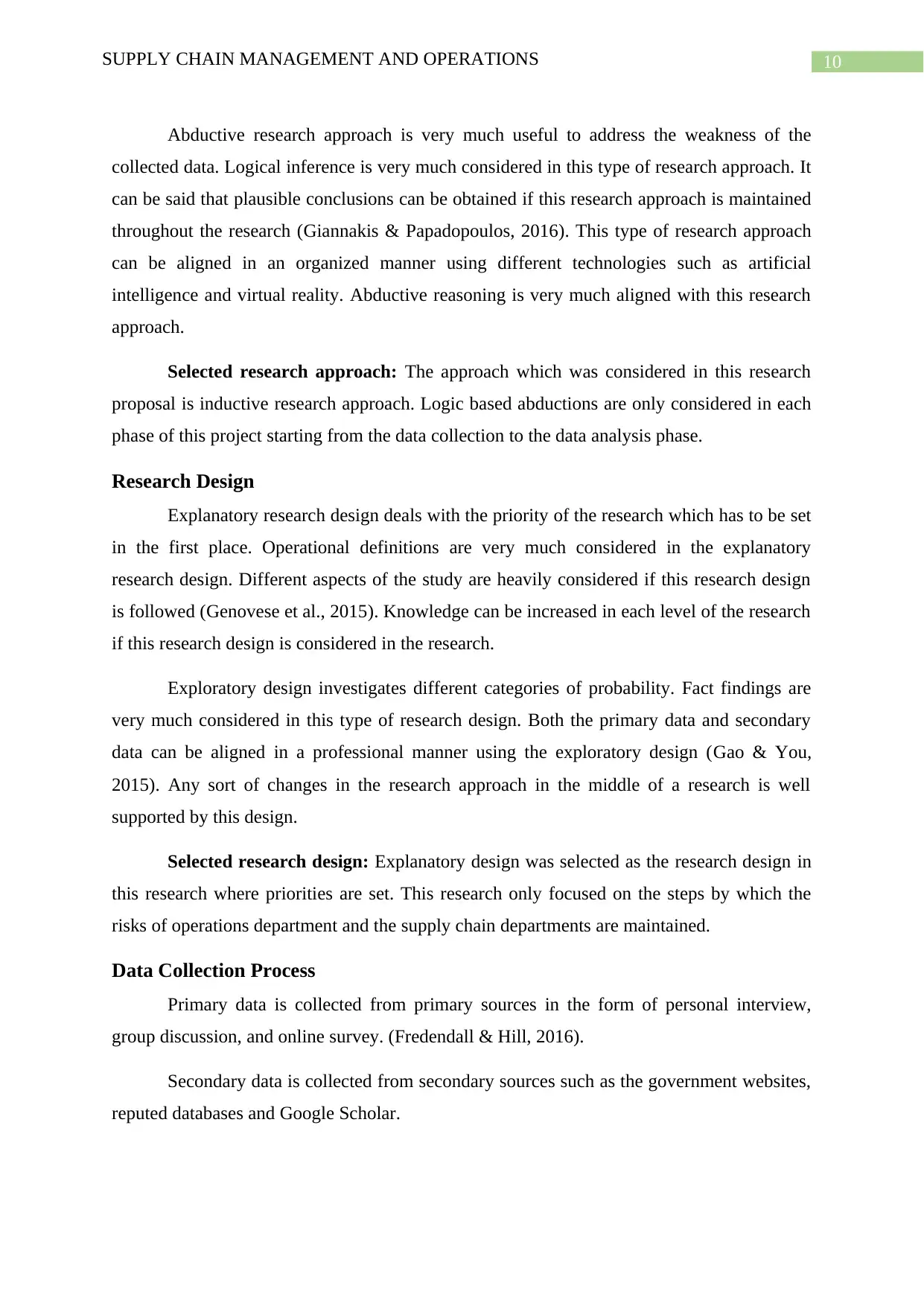
10SUPPLY CHAIN MANAGEMENT AND OPERATIONS
Abductive research approach is very much useful to address the weakness of the
collected data. Logical inference is very much considered in this type of research approach. It
can be said that plausible conclusions can be obtained if this research approach is maintained
throughout the research (Giannakis & Papadopoulos, 2016). This type of research approach
can be aligned in an organized manner using different technologies such as artificial
intelligence and virtual reality. Abductive reasoning is very much aligned with this research
approach.
Selected research approach: The approach which was considered in this research
proposal is inductive research approach. Logic based abductions are only considered in each
phase of this project starting from the data collection to the data analysis phase.
Research Design
Explanatory research design deals with the priority of the research which has to be set
in the first place. Operational definitions are very much considered in the explanatory
research design. Different aspects of the study are heavily considered if this research design
is followed (Genovese et al., 2015). Knowledge can be increased in each level of the research
if this research design is considered in the research.
Exploratory design investigates different categories of probability. Fact findings are
very much considered in this type of research design. Both the primary data and secondary
data can be aligned in a professional manner using the exploratory design (Gao & You,
2015). Any sort of changes in the research approach in the middle of a research is well
supported by this design.
Selected research design: Explanatory design was selected as the research design in
this research where priorities are set. This research only focused on the steps by which the
risks of operations department and the supply chain departments are maintained.
Data Collection Process
Primary data is collected from primary sources in the form of personal interview,
group discussion, and online survey. (Fredendall & Hill, 2016).
Secondary data is collected from secondary sources such as the government websites,
reputed databases and Google Scholar.
Abductive research approach is very much useful to address the weakness of the
collected data. Logical inference is very much considered in this type of research approach. It
can be said that plausible conclusions can be obtained if this research approach is maintained
throughout the research (Giannakis & Papadopoulos, 2016). This type of research approach
can be aligned in an organized manner using different technologies such as artificial
intelligence and virtual reality. Abductive reasoning is very much aligned with this research
approach.
Selected research approach: The approach which was considered in this research
proposal is inductive research approach. Logic based abductions are only considered in each
phase of this project starting from the data collection to the data analysis phase.
Research Design
Explanatory research design deals with the priority of the research which has to be set
in the first place. Operational definitions are very much considered in the explanatory
research design. Different aspects of the study are heavily considered if this research design
is followed (Genovese et al., 2015). Knowledge can be increased in each level of the research
if this research design is considered in the research.
Exploratory design investigates different categories of probability. Fact findings are
very much considered in this type of research design. Both the primary data and secondary
data can be aligned in a professional manner using the exploratory design (Gao & You,
2015). Any sort of changes in the research approach in the middle of a research is well
supported by this design.
Selected research design: Explanatory design was selected as the research design in
this research where priorities are set. This research only focused on the steps by which the
risks of operations department and the supply chain departments are maintained.
Data Collection Process
Primary data is collected from primary sources in the form of personal interview,
group discussion, and online survey. (Fredendall & Hill, 2016).
Secondary data is collected from secondary sources such as the government websites,
reputed databases and Google Scholar.
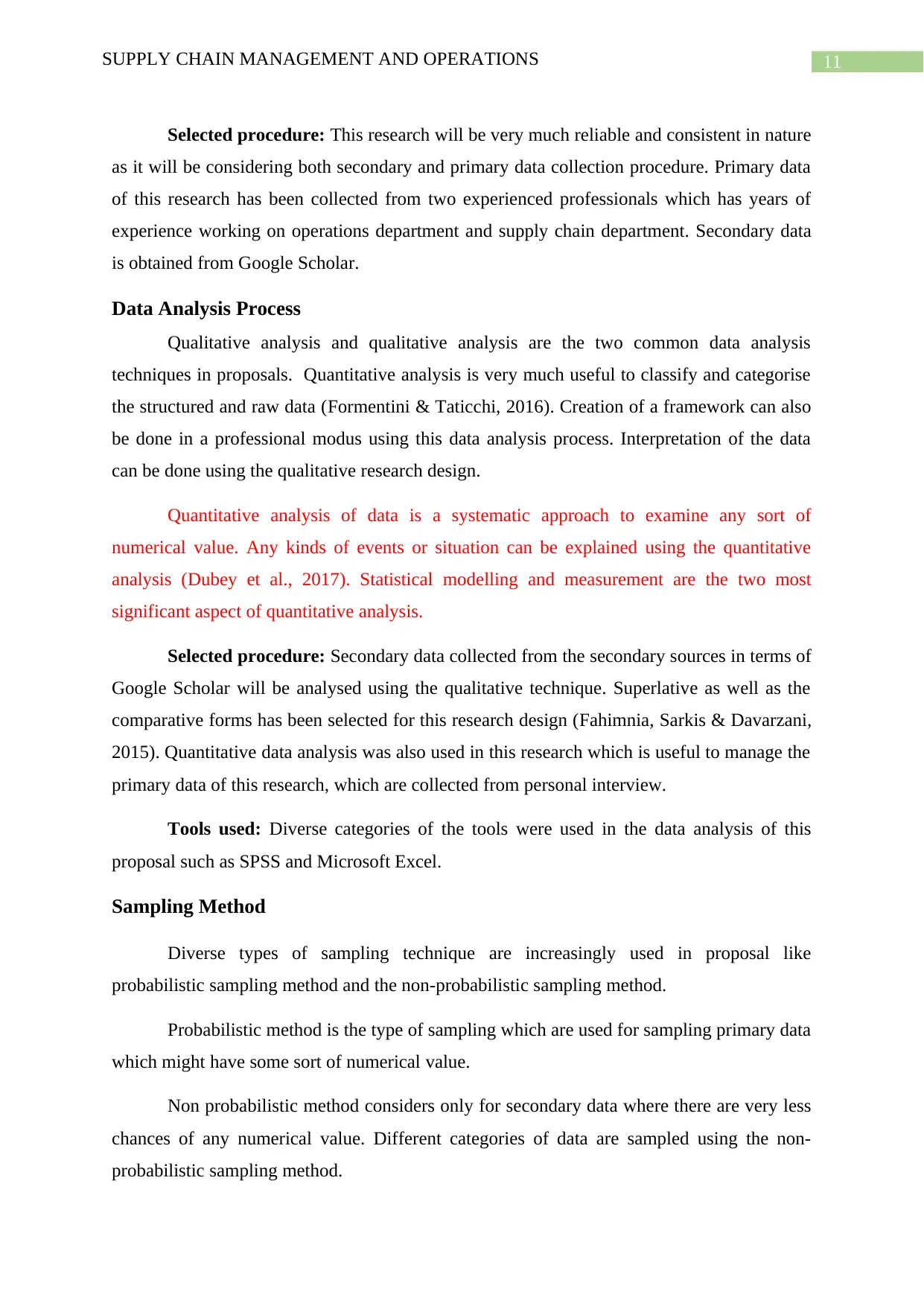
11SUPPLY CHAIN MANAGEMENT AND OPERATIONS
Selected procedure: This research will be very much reliable and consistent in nature
as it will be considering both secondary and primary data collection procedure. Primary data
of this research has been collected from two experienced professionals which has years of
experience working on operations department and supply chain department. Secondary data
is obtained from Google Scholar.
Data Analysis Process
Qualitative analysis and qualitative analysis are the two common data analysis
techniques in proposals. Quantitative analysis is very much useful to classify and categorise
the structured and raw data (Formentini & Taticchi, 2016). Creation of a framework can also
be done in a professional modus using this data analysis process. Interpretation of the data
can be done using the qualitative research design.
Quantitative analysis of data is a systematic approach to examine any sort of
numerical value. Any kinds of events or situation can be explained using the quantitative
analysis (Dubey et al., 2017). Statistical modelling and measurement are the two most
significant aspect of quantitative analysis.
Selected procedure: Secondary data collected from the secondary sources in terms of
Google Scholar will be analysed using the qualitative technique. Superlative as well as the
comparative forms has been selected for this research design (Fahimnia, Sarkis & Davarzani,
2015). Quantitative data analysis was also used in this research which is useful to manage the
primary data of this research, which are collected from personal interview.
Tools used: Diverse categories of the tools were used in the data analysis of this
proposal such as SPSS and Microsoft Excel.
Sampling Method
Diverse types of sampling technique are increasingly used in proposal like
probabilistic sampling method and the non-probabilistic sampling method.
Probabilistic method is the type of sampling which are used for sampling primary data
which might have some sort of numerical value.
Non probabilistic method considers only for secondary data where there are very less
chances of any numerical value. Different categories of data are sampled using the non-
probabilistic sampling method.
Selected procedure: This research will be very much reliable and consistent in nature
as it will be considering both secondary and primary data collection procedure. Primary data
of this research has been collected from two experienced professionals which has years of
experience working on operations department and supply chain department. Secondary data
is obtained from Google Scholar.
Data Analysis Process
Qualitative analysis and qualitative analysis are the two common data analysis
techniques in proposals. Quantitative analysis is very much useful to classify and categorise
the structured and raw data (Formentini & Taticchi, 2016). Creation of a framework can also
be done in a professional modus using this data analysis process. Interpretation of the data
can be done using the qualitative research design.
Quantitative analysis of data is a systematic approach to examine any sort of
numerical value. Any kinds of events or situation can be explained using the quantitative
analysis (Dubey et al., 2017). Statistical modelling and measurement are the two most
significant aspect of quantitative analysis.
Selected procedure: Secondary data collected from the secondary sources in terms of
Google Scholar will be analysed using the qualitative technique. Superlative as well as the
comparative forms has been selected for this research design (Fahimnia, Sarkis & Davarzani,
2015). Quantitative data analysis was also used in this research which is useful to manage the
primary data of this research, which are collected from personal interview.
Tools used: Diverse categories of the tools were used in the data analysis of this
proposal such as SPSS and Microsoft Excel.
Sampling Method
Diverse types of sampling technique are increasingly used in proposal like
probabilistic sampling method and the non-probabilistic sampling method.
Probabilistic method is the type of sampling which are used for sampling primary data
which might have some sort of numerical value.
Non probabilistic method considers only for secondary data where there are very less
chances of any numerical value. Different categories of data are sampled using the non-
probabilistic sampling method.
⊘ This is a preview!⊘
Do you want full access?
Subscribe today to unlock all pages.

Trusted by 1+ million students worldwide
1 out of 20
Related Documents
Your All-in-One AI-Powered Toolkit for Academic Success.
+13062052269
info@desklib.com
Available 24*7 on WhatsApp / Email
![[object Object]](/_next/static/media/star-bottom.7253800d.svg)
Unlock your academic potential
Copyright © 2020–2025 A2Z Services. All Rights Reserved. Developed and managed by ZUCOL.





